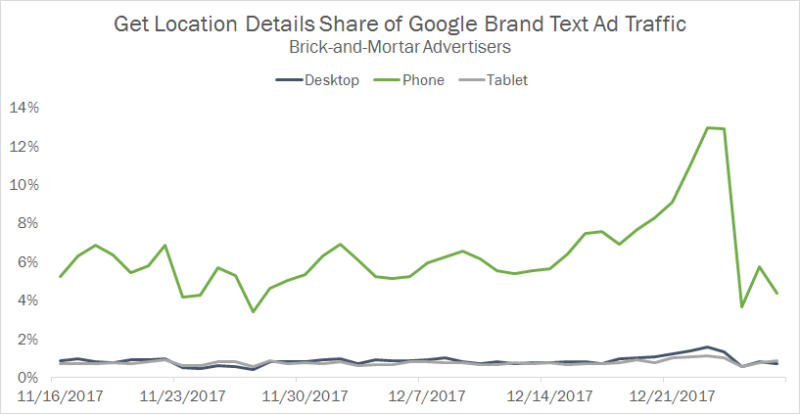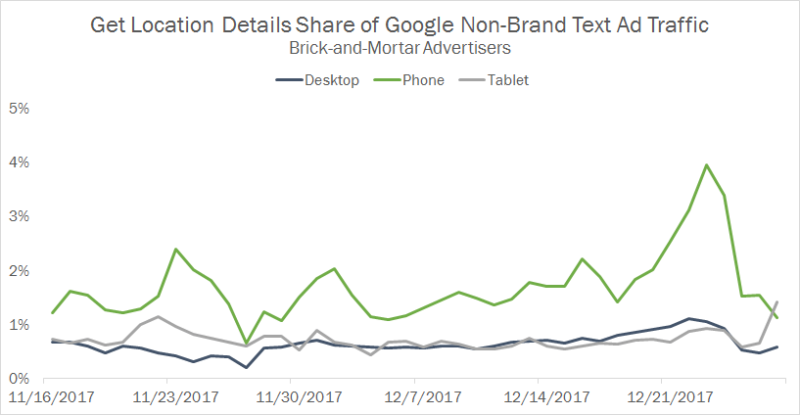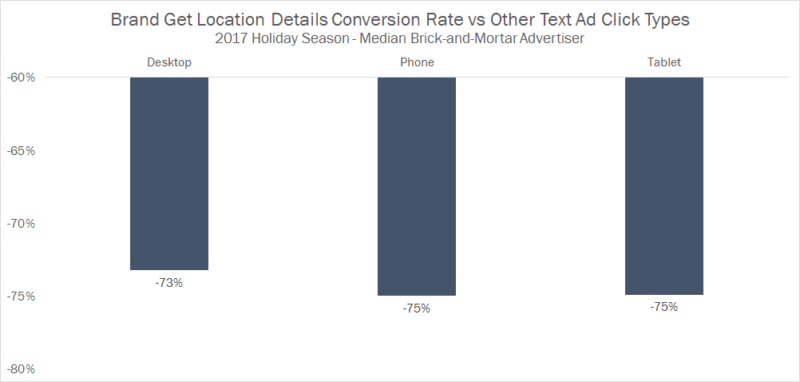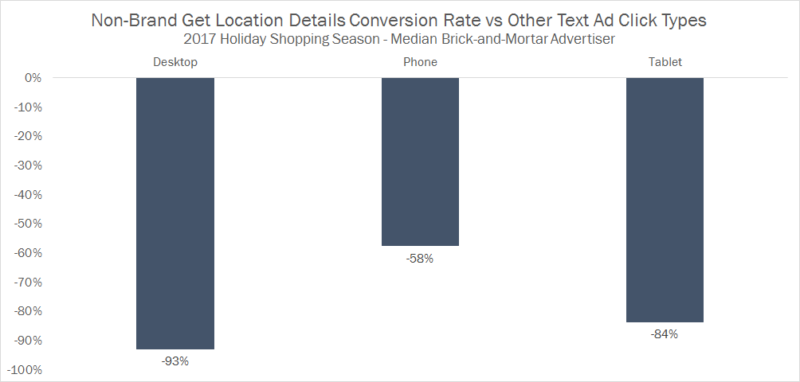
Ahead of the 2017 holiday season, I wrote a column detailing how much more important locally focused ads became during the 2016 holiday shopping season, namely Local Inventory Ads and ads on Google Maps. Analyzing last year’s data, I found that searchers became increasingly likely to search for both brand and non-brand keywords within Google Maps as the number of days before Christmas shrank, and the share of traffic coming from ads featured in Google Maps likewise rose.
Taking a look at the most recent holiday period, we find that searchers once again turned to navigational apps in the lead-up to December 25 to find store information for last-minute purchases. This led to the highest one-day share of traffic ever coming from Google Maps ads.
Google Maps phone traffic for brand keywords spikes
The device type with the biggest share of traffic coming from the “Get location details” click type (which comes from Google Maps ads) is naturally phones, given the high rate of navigational app use. Looking at brand text ads, which are seeing a much higher share of traffic from Maps ads than are non-brand keywords, we find that phone share reached 13 percent on both December 23 and 24.

This is the highest share ever observed across the sample studied, and some brick-and-mortar advertisers saw as high as 20 percent of all brand phone traffic come from “Get location details” on Christmas Eve.
There was a similar spike on the last two days before Christmas for non-brand keywords, though “Get location details” phone traffic share topped out at 4 percent for these keywords.

The last two days before Christmas are a crucial period of last-minute purchases for many brick-and-mortar retailers, and searchers are increasingly finding their way in-store via searches in navigational apps.
Google is monetizing this traffic via location extensions, and advertisers’ ads are automatically opted into showing in Maps for any keyword campaigns which have active location extensions. Further, this traffic is defined as coming from google.com, and no AdWords search campaign can exclude google.com from targeting.
Given that most brick-and-mortar advertisers deploy active location extensions as a best practice, most marketers don’t necessarily have to do anything to take advantage of this traffic. However, there are some performance differences to be aware of when compared to other ad traffic.
Mobile Maps traffic more expensive than other search traffic
Comparing “Get location details”’ brand CPC to other click types for the median brick-and-mortar advertiser during the holiday season, we find that these clicks produced a 30 percent higher CPC on phone and 83 percent higher on tablet, while actually proving 15 percent less expensive on desktop.

The same directional trends were observed for non-brand keywords, though the difference was more modest on phones and tablets, while on desktop, “Get location details” clicks were less than half as expensive as other clicks.

Unfortunately, there’s no way for advertisers to adjust bids for Google Maps traffic relative to other click types, and bids should be set based on the overall expected value of all click types a keyword is garnering.
However, the expected value of Google Maps ads is naturally tied much more to in-store purchases than online conversions.
Online conversion rate significantly lower for Maps ads than for other search traffic
Looking at single-device conversion rate, “Get location details” clicks convert at just about one-quarter the rate of other click types across all three device types for brand keywords.

On the non-brand side, relative conversion rate is even worse for desktop and tablet devices but actually comes in a bit closer on phones.

With these differences, online conversion rate for a particular campaign or keyword might decline with the rise in Maps traffic, especially on key days like Christmas Eve. Thus, it’s important to have some measure of the offline impact of these clicks.
Fortunately for advertisers making use of Google store visit tracking, click type reports can include store visit data. For one of the brick-and-mortar advertisers from our “Get location details” sample, these clicks produced 13 times more store visits than online conversions during the period studied!
However, not all brick-and-mortar advertisers can take advantage of Google store visit tracking, as there are some requirements for eligibility. Brands that don’t meet the specifications below should talk to their agency or Google rep to explore available in-store tracking options.
![]()
Adequately valuing the in-store impact of ads will give advertisers a more complete view into how Maps ads are helping to drive sales.
Conclusion
Google’s efforts to monetize Maps traffic are clearly starting to shift the makeup of traffic for brick-and-mortar brands, especially on key in-store shopping days like Christmas Eve. As such, it’s becoming increasingly important for AdWords campaigns to have active location extensions in order to take advantage of navigational searches.
However, the online value of these ads is not equal to that of other search ads, since navigational app searchers are naturally looking to find directions to a physical store location. Thus, tracking the offline impact of these ads, or at least applying some sensible estimate of offline impact to expected value for the purposes of bidding, is becoming increasingly necessary with the rise of “Get location details” clicks. This will continue to be the case for brick-and-mortar brands over the course of 2018.
Contributing authors are invited to create content for Search Engine Land and are chosen for their expertise and contribution to the search community. Our contributors work under the oversight of the editorial staff and contributions are checked for quality and relevance to our readers. The opinions they express are their own.



